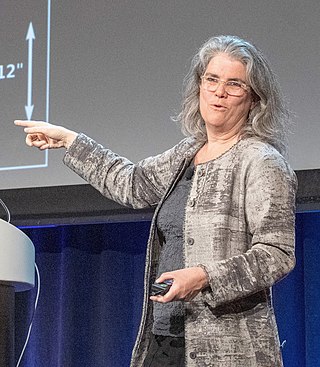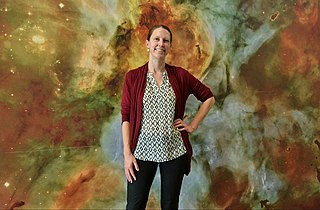Related Research Articles

Annie Jump Cannon was an American astronomer whose cataloging work was instrumental in the development of contemporary stellar classification. With Edward C. Pickering, she is credited with the creation of the Harvard Classification Scheme, which was the first serious attempt to organize and classify stars based on their temperatures and spectral types. She was nearly deaf throughout her career after 1893, as a result of scarlet fever. She was a suffragist and a member of the National Women's Party.

Helen Battles Sawyer Hogg was an American-Canadian astronomer who pioneered research into globular clusters and variable stars. She was the first female president of several astronomical organizations and a scientist when many universities would not award scientific degrees to women. Her scientific advocacy and journalism included astronomy columns in the Toronto Star and the Journal of the Royal Astronomical Society of Canada. She was considered a "great scientist and a gracious person" over a career of sixty years.
Sallie Louise Baliunas is a retired astrophysicist. She formerly worked at the Center for Astrophysics | Harvard & Smithsonian and was the Deputy Director of the Mount Wilson Observatory from 1991 to 2003.
The Newton Lacy Pierce Prize in Astronomy is awarded annually by the American Astronomical Society to a young astronomer for outstanding achievement in observational astronomical research. The prize is named after Newton Lacy Pierce, an American astronomer.

Andrea Mia Ghez is an American astrophysicist, Nobel laureate, and professor in the Department of Physics and Astronomy and the Lauren B. Leichtman & Arthur E. Levine chair in Astrophysics, at the University of California, Los Angeles. Her research focuses on the center of the Milky Way galaxy.
Amy J. Barger is an American astronomer and Henrietta Leavitt Professor of Astronomy at the University of Wisconsin–Madison. She is considered a pioneer in combining data from multiple telescopes to monitor multiple wavelengths and in discovering distant galaxies and supermassive black holes, which are outside of the visible spectrum. Barger is an active member of the International Astronomical Union.
Paula Szkody is a professor in the Department of Astronomy at the University of Washington in Seattle. She served as president of the American Astronomical Society from 2020 to 2022.

Alyssa Ann Goodman is the Robert Wheeler Willson Professor of Applied Astronomy at Harvard University, former co-director for Science at the Radcliffe Institute for Advanced Study, Research Associate of the Smithsonian Institution, and the founding director of the Harvard Initiative in Innovative Computing.
Lisa Jennifer Kewley is an Australian Astrophysicist and current Director of the Center for Astrophysics | Harvard & Smithsonian. Previously, Kewley was Director of the ARC Centre of Excellence for All Sky Astrophysics in 3-D and ARC Laureate Fellow at the Australian National University College of Physical and Mathematical Sciences, where she was also a Professor. Specialising in galaxy evolution, she won the Annie Jump Cannon Award in Astronomy in 2005 for her studies of oxygen in galaxies, and the Newton Lacy Pierce Prize in Astronomy in 2008. In 2014 she was elected a fellow of the Australian Academy of Science. In 2020 she received the James Craig Watson Medal. In 2021 she was elected as an international member of the National Academy of Sciences. In 2022 she became the first female director of the Center for Astrophysics | Harvard & Smithsonian.
Alan Michael Dressler is an American astronomer at the Carnegie Institution for Science of Washington, D.C. Among his works is the popularization Voyage To The Great Attractor: Exploring Intergalactic Space.

Ida Barney was an American astronomer, best known for her 22 volumes of astrometric measurements on 150,000 stars. She was educated at Smith College and Yale University and spent most of her career at the Yale University Observatory. She was the 1952 recipient of the Annie J. Cannon Award in Astronomy.

Helen Dodson Prince was an American astronomer who pioneered work in solar flares at the University of Michigan.

Heather A. Knutson is an astrophysicist and professor of planetary science at California Institute of Technology in the Division of Geological and Planetary Sciences. Her research is focused on the study of exoplanets, their composition and formation.
Kristen Sellgren is an American retired astronomer and Professor Emerita at the College of Natural and Mathematical Sciences, Ohio State University. She won the Newton Lacy Pierce Prize in Astronomy in 1990. She is the founder of American Astronomical Society's Committee for Sexual-Orientation & Gender Minorities in Astronomy (SGMA).
Nadia Zakamska is a Russian-American astronomer who is a professor at Johns Hopkins University.

Vassiliki Kalogera is a Greek astrophysicist. She is a professor at Northwestern University and the director of the Center for Interdisciplinary Exploration and Research in Astrophysics (CIERA). She is a leading member of the LIGO Collaboration that observed gravitational waves in 2015.
Elizabeth Lada is an American astronomer whose self-described research interests include "understanding the origin, properties, evolution and fate of young embedded clusters within molecular clouds".
Rebekah Dawson is an American astrophysicist and an associate professor of astronomy and astrophysics at Pennsylvania State University. Her research focuses on simulating the evolution of exoplanetary orbits and compositions to better understand how planetary systems form.

James Moran is an American radio astronomer living in Massachusetts, USA. He was a professor of Astronomy at Harvard University from 1989 through 2016, a senior radio astronomer at the Smithsonian Astrophysical Observatory from 1981 through 2020 and the director of the Submillimeter Array during its construction and early operational phases from 1995 through 2005. In 1998 he was elected to the National Academy of Sciences, in 2010 to the American Academy of Arts and Sciences, and in 2020 to the American Philosophical Society. He is currently the Donald H. Menzel Professor of Astrophysics, Emeritus, at Harvard University.

Laura Kreidberg is an American astronomer who primarily studies exoplanets. Since 2020, she has been director at the Max Planck Institute for Astronomy (MPIA) in Heidelberg, where she is leading the Atmospheric Physics of Exoplanets (APEx) department. She is MPIA's managing director as of January 2024.
References
- 1 2 3 "Dinerstein". McDonald Observatory. Retrieved 1 June 2016.
- 1 2 3 4 "UT Astronomy". Faculty. 16 January 1997. Archived from the original on 10 January 1997. Retrieved 1 June 2016.
- ↑ "Newton Lacy Pierce Prize in Astronomy". American Astronomical Society. 27 June 2016. Retrieved 1 June 2016.
- ↑ Dalcanton, Julianne (23 August 2010). "D". Women in Astronomy: A Comprehensive Bibliography (Science Reference Services, Library of Congress) (in French). Retrieved 1 June 2016.
- ↑ "Harriet Dinerstein - Astronomy". www.as.utexas.edu. Archived from the original on 1997-01-10. Retrieved 2020-10-11.